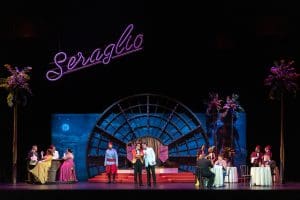Even the oddest of retellings of Mozart operas can make for a satisfying evening if the peerless music is executed beautifully enough. Stage director Alison Moritz and her design team are to be applauded for their whimsical reinterpretation of The Abduction from the Seraglio, which they have set not in an 18th-century Turkish palace-harem but in a 1940s Los Angeles nightclub. But this version of Mozart’s first theatrical “hit,” which had its Lyric Opera premiere on September 21st at the Kauffman Center, might have felt less fulfilling had it not been for the exceptional caliber of the performances.

All photos by Karli Cadel
Granted, Mozart is partly to blame for the conundrum of Abduction, which is purportedly cast in the farcical 18th-century sub-genre of “rescue opera” but contains music that is often way too serious for the frothy genre. Alison has provided us with plenty of laughs that are in keeping with the work’s satirical vein, yet the Lyric’s vocalists take to heart the borderline-tragic dilemmas of separation and thwarted love that the protagonists find themselves in.
In this version, Konstanze (soprano Kathryn Lewek) and her friend Blonde (soprano Rachele Gilmore) are being held against their will in the employ of the Pasha Selim (Matthew J. Williamson), a sort of mobster who has been trying his best to woo his would-be “gun-moll,” Konstanze. Selim is reluctant to let her go, not only because he wants her to himself, but also because she is the star singer of the Middle Eastern-themed “Club Seraglio.” Konstanze’s real love is clean-cut Belmonte (tenor Ben Bliss), who plots with his friend Pedrillo (tenor Joseph Leppek) to escape the clutches of Selim and his faux-imperious manager/bouncer, Osmin (bass Matt Boehler). Yes, it’s as silly as it sounds.
 Yet some of the singing is so spectacular that one almost doesn’t mind. We are first greeted with Matt’s gorgeous bass voice, delivering his already-too-serious “Wer ein Liebchen hat gefunden” with its severely threatening subsequent aria. Just as we are beginning to marvel at this mahogany sound, Kansas City native Ben Bliss enchants us with his famous “O wie ängstlich” aria, which he sings about as gracefully as any Mozart tenor working today. His light-as-air voice is uniformly suave and gleaming throughout its range, with nothing forced or overwrought. Nevertheless we can virtually feel the palpitations as he sings of the “thumping of his love-filled heart.” His composure, moreover, is regal and constrained, as befitting a “white knight” coming to rescue his beloved.
Yet some of the singing is so spectacular that one almost doesn’t mind. We are first greeted with Matt’s gorgeous bass voice, delivering his already-too-serious “Wer ein Liebchen hat gefunden” with its severely threatening subsequent aria. Just as we are beginning to marvel at this mahogany sound, Kansas City native Ben Bliss enchants us with his famous “O wie ängstlich” aria, which he sings about as gracefully as any Mozart tenor working today. His light-as-air voice is uniformly suave and gleaming throughout its range, with nothing forced or overwrought. Nevertheless we can virtually feel the palpitations as he sings of the “thumping of his love-filled heart.” His composure, moreover, is regal and constrained, as befitting a “white knight” coming to rescue his beloved.
The first half really belongs to Kathryn, though, who seems to do most of the singing in this concatenation of Mozart’s Act I and part of Act II. (Abduction‘s three acts have been compressed into two parts here.) Dressed in a sparkly ruby-red gown (the deliciously detailed period costumes are by the Lyric’s own Mary Traylor), she sings her dead-serious “Ach ich liebte” to the tuxedo-clad club denizens. Yes, instead of “A-Tisket, A-Tasket” we get: “My joy has vanished … and now my eyes swim in tears and sorrow fills my breast.” No one seems fazed by her misery, which comes on the heels of a jovial spar between Osmin and Pedrillo (the latter posing as a garish ne’er-do-well).
As if this weren’t serious enough, Konstanze retires to her dressing room to sing the high-tragic “Traurigkeit” aria (with Selim listening, furtively, from outside the door), in which we get the impression she is way more miserable than your average gangster’s gal. Though the opera seria mood is jarringly excessive, it’s difficult not to be utterly taken with Kathryn’s voice: It is clear as a bell and filled with glowing pathos: Even at pianissimo it remains rounded and full-bodied.
Fortunately, a bit of lightness enters the foray, finally, in the form of Blonde’s “Durch Zärtlichkeit und Schmeicheln,” sung with a clear, unaffected soprano.
Steven C. Kemp’s ingenious set design comes into play here: It is essentially a massive, rotating rectangular “block.” On one side is the glitzy nightclub, lit with subtle, inventive shading by lighting designer Anshuman Bhatia, and when the slab rotates 180 degrees it reveals Konstanze’s dressing room. The ends of the “slab” are used as well: On one end is a fire escape from which the ladies will be “re-abducted,” and on the other is Selim’s plush “casting couch.”
It is from the latter that Kathryn brings down the house with her “Martern aller Arten” aria, in which she resists Selim’s aggressive advances (though just barely) in a fierce display of vocal and emotional pyrotechnics unlike anything I’ve seen in a production of this opera. It made sense, actually, to end the first half here.
At the outset of the second half, Pedrillo sings his courage-summoning aria “Frisch zum Kampfe” perched so high above the stage that one feels he has every reason to be terrified. Still managing to strike a comic mood, Joseph sings with clarity and enormous charm. He manages to get Osmin drunk enough to allow for the grand escape, but not before Belmonte delivers his delightful “Wenn der Freude…” Again we were struck (here as in his final aria) by the warmth and depth that Ben can instill in Mozart’s straightforward music.
It is only here that Belmonte is finally joined with Konstanze, and as the comic duo (Blonde and Pedrillo) argue about fidelity in their own jocose manner, the lead couple have a more serious discussion about “fidelity” and its importance to their future. As lovely as the quartet may be, though, we recognize that is a “false conclusion”: As soon as Osmin awakens, he is back to his bossy self.
Pedrillo’s “Im Mohrenland gefangen war” again seems out-of-place at this point (though it’s such an inspired tune that we are enticed into listening intently), all the more so because Konstanze’s and Belmonte’s “Meinetwegen” duet is so serious that we are again thrown as if into a completely different genre. But only for a few minutes.
Selim’s deus ex machina seems as overly tidy here as always does, but again we are charmed out of caring because the final “summing-up” (or vaudeville, as it was called in the 18th century) is one of the loveliest of finales. The orchestra, which had up to this point sounded resonant and precise under Michael Christie’s virtuosic command, came to explosive life in the Turkish finale (the “Janissary sound” having sounded a bit tame in the Overture), as did the precise and resonant chorus (as trained by Piotr Wiśniewski).
—By Paul Horsley
The Abduction from the Seraglio continues through September 29th. Call 816-471-7344 or go to kcopera.org.
To reach Paul Horsley, performing arts editor; send an email to paul@kcindependent.com or find him on Facebook (paul.horsley.501) or Twitter (@phorsleycritic).